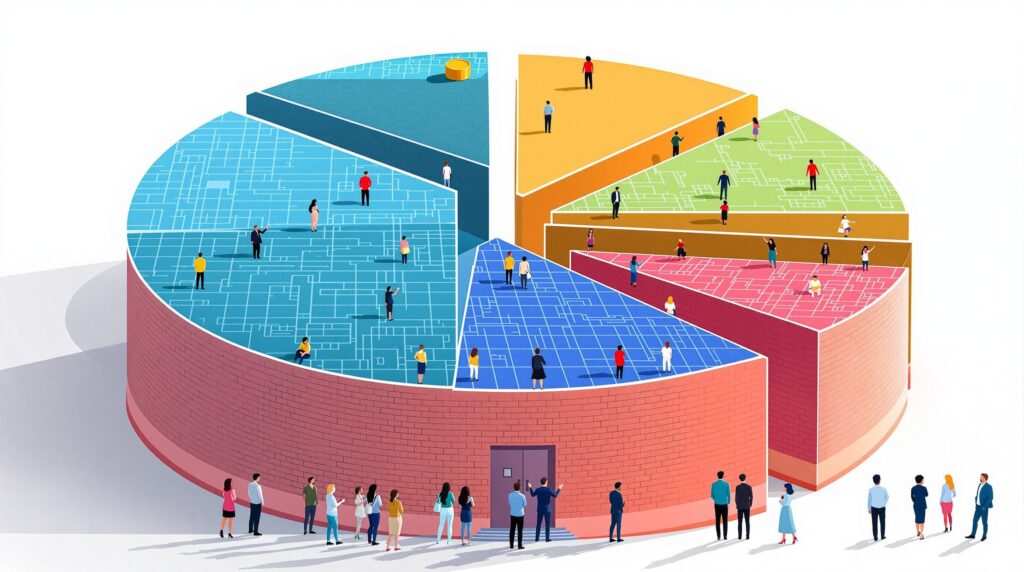[rev_slider alias=”slider-1″][/rev_slider]
Understanding Layer 1 Blockchains
Layer 1 blockchains are the foundational networks that underpin most decentralized applications in the crypto space. These are base networks like Bitcoin, Ethereum, and Cardano upon which other services and protocols are built. Understanding their architecture, security protocols, and scalability challenges is crucial for grasping their role as the backbone of crypto innovation. But what exactly are Layer 1 blockchains, and why are they so pivotal?
Layer 1 blockchains are primary networks that operate independently, providing the base framework for all applications and transactions within their ecosystem.
Much like the railway tracks that support the entire train network, Layer 1 blockchains are essential for the functioning of the entire cryptocurrency ecosystem. They establish the ruleset for everything from data sharing to consensus mechanisms. Bitcoin and Ethereum are prime examples of platforms that offer this fundamental infrastructure, enabling other applications and protocols to thrive.
Key Characteristics of Layer 1 Blockchains
To fully understand why Layer 1 blockchains are so crucial, here are a few key characteristics:
- Independence: Unlike Layer 2 solutions, Layer 1 blockchains function independently without relying on other networks.
- Security Focus: They incorporate robust security measures to protect transactions and user data.
- Scalability Challenges: The design often emphasizes security and decentralization, sometimes at the cost of scalability.
- Smart Contracts Capability: Many Layer 1 networks support developing and executing smart contracts, which are self-executing contracts with the terms directly written into code.
While innovative, these blockchains face inherent limitations when scaling. Increased traffic can lead to slower transaction speeds and higher costs, forming a significant barrier for broader adoption, particularly in Africa, where financial inclusivity relies on accessible technology solutions.
Jara aims to bridge these challenges by pioneering affordable, scalable blockchain solutions tailored for Africa’s unique needs.
The Role of Layer 1 Blockchains in Africa
Africa is on the verge of a digital transformation, with rapidly increasing internet penetration and mobile connectivity. Layer 1 blockchains hold the potential to revolutionize this landscape by providing secure, transparent, and decentralized financial systems. With most Africans excluded from traditional banking, blockchain technology, as facilitated by platforms like Jara, can offer an alternative means for managing finances, accessing credit, and conducting business. Especially with Africa’s vast portfolio of high-potential assets, blockchain technologies unlock value and drive economic empowerment.
However, for Africans to fully benefit from blockchain innovations, scalability and cost-effectiveness remain critical obstacles. Layer 1 solutions must evolve to meet the high transaction throughput and low access costs necessary for mass adoption on the continent.
$JARA token is central to this mission, providing access and utility within the Jara ecosystem, enabling Africans to engage seamlessly in a global digital economy.
Notable Layer 1 Blockchains and Their Features
When looking at leading Layer 1 blockchains, three major platforms stand out for their unique attributes and influence:
- Bitcoin: Known as the pioneer of blockchain technology, Bitcoin focuses on a decentralized digital currency with strong security measures but faces scalability challenges due to its proof-of-work consensus mechanism.
- Ethereum: Famous for its smart contract functionality, allowing developers to create decentralized applications (dApps). Ethereum is transitioning from proof-of-work to proof-of-stake to enhance scalability.
- Cardano: Praised for its rigorous academic approach, it uses a proof-of-stake consensus mechanism from the start, aiming for sustainability, scalability, and interoperability.
Each of these platforms offers unique qualities that contribute to the evolving crypto landscape, understanding them provides insights into their positioning and future directions.
In summary, Layer 1 blockchains power the backbone of the crypto world, serving as an integral part of the evolving digital landscape in Africa and beyond. As the ecosystem continues to grow, platforms like Jara that innovate upon these foundational layers will be key to driving a digital revolution in Africa.
The Significance of Layer 2 Solutions
Layer 2 Enhancement Approaches
Layer 2 blockchain solutions represent a pivotal development in cryptocurrency networks, building upon existing Layer 1 networks to significantly enhance their performance. You might wonder, how exactly do these solutions improve performance? Simply put, they enhance scalability and transaction speeds, addressing key inefficiencies in the base layers such as Ethereum and Bitcoin.
Why are Layer 2 solutions necessary? Layer 2 solutions are crucial for scalability and cost efficiency, allowing cryptocurrencies to handle more transactions without overloading the network.
The significance of Layer 2 solutions lies in their efficiency. Imagine the internet with no broadband – functioning but frustratingly slow and unable to handle high traffic. Similarly, Layer 2 solutions act as the much-needed broadband for the blockchain world by providing faster speeds and lower fees. For instance, Lightning Network for Bitcoin allows transactions to be conducted off the main blockchain, culminating in quicker processing times and reduced costs. This improvement is crucial for mainstream adoption of cryptocurrencies, especially in regions like Africa, where financial infrastructures are rapidly evolving.
To better grasp the impact of these enhancements, consider Africa’s thriving digital marketplace, where the need for rapid and cost-effective transactions is paramount. Jara’s ecosystem showcases an exemplary model of integration, leveraging a proprietary Layer 2 blockchain that empowers users with low-cost transactions and accessible resources. Besides just offering the $JARA token, Jara is essentially paving the way for an empowered digital economy in Africa.
“With Jara, you’re not just investing in a token—you’re investing in the future of an entire continent.”
Layer 2 solutions offer a myriad of benefits, including:
- Scalability: By processing transactions off the main chain, they help increase the network’s capacity.
- Cost Reduction: Lower transaction fees make it affordable for everyday use.
- Speed: Faster transactions enhance user experience and allow the blockchain to support real-time applications.
- Security: While transactions occur off-chain, final settlements still happen on-chain, maintaining the security of the blockchain.
Efforts by projects like Optimistic Rollups are also noteworthy. They aggregate transactions into one, then post the data to the main blockchain, effectively distributing computational load and speeding up the process. Optimistic Rollups are expected to revolutionize the Ethereum ecosystem by slashing costs and providing greater throughput, making Ethereum applications more accessible to users worldwide.
Layer 2 solutions are progressively transforming the blockchain landscape. As they evolve, they will continue to impact not just cryptocurrency transactions but also expand the potential of decentralized applications (dApps) and real-world applications. Through these advancements, you’ll find that Layer 2 solutions are truly the unsung heroes of blockchain innovation, driving the technology closer to becoming an integral part of global financial systems.
[rev_slider alias=”text-call-cta”][/rev_slider]
Comparing Layer 1 and Layer 2 Blockchain Solutions
Both Layer 1 and Layer 2 solutions are pivotal to the evolution of the blockchain ecosystem, each serving unique purposes. While Layer 1 blockchains provide security and decentralization, Layer 2 solutions offer scalability and efficiency. Comparing their roles emphasizes the importance of innovation and adaptability in driving blockchain technology forward.
What are Layer 1 blockchains? Layer 1 blockchains form the base layer of the blockchain network, ensuring security, decentralization, and functionality.
Layer 1 blockchains, like Bitcoin and Ethereum, are the backbone of the crypto world. They operate independently and manage all on-chain functionality, including transactions and smart contracts. However, they often face challenges such as limited scalability and slower transaction speeds.
On the other hand, Layer 2 solutions are built on top of Layer 1 blockchains to address these challenges. They enable faster transaction speeds and lower fees by conducting transactions off-chain and only settling on the Layer 1 blockchain. This division allows the main chain to maintain its robustness and security while offering enhanced scalability.
What is a Layer 2 blockchain solution? Layer 2 solutions are enhancements built atop Layer 1 blockchains, aimed at improving system scalability and transaction efficiency.
Benefits of Layer 1 Solutions
- Security and Decentralization: Layer 1 blockchains provide a secure and decentralized network, reducing the risk of malicious attacks.
- Public Accessibility: They enable anyone to participate and validate transactions, promoting transparency.
- Foundation for Innovation: They serve as stable platforms for creating decentralized applications (dApps).
Advantages of Layer 2 Solutions
- Scalability: By conducting transactions off-chain, they significantly increase the transaction throughput.
- Cost Efficiency: Lower transaction fees make blockchain technology accessible to a wider audience.
- Flexibility: They offer adaptable solutions to meet growing demands and diverse use cases.
A good analogy for understanding the relationship between Layer 1 and Layer 2 solutions is the road and highway system in a city. Layer 1 blockchains are akin to the main roads, essential for reaching the destination, ensuring everyone can access them. However, when traffic increases, Layer 2 solutions, much like highways, offer alternate routes to handle the congestion, allowing for faster and smoother travel.
Layer 1 prioritizes security, decentralization, and base functionality, whereas Layer 2 enhances speed and efficiency by handling more transactions.
Projects like Jara are capitalizing on this technology, harnessing the power of Layer 2 to drive Africa’s digital transformation through innovative blockchain solutions. By participating in the Jara ecosystem, users not only engage with a burgeoning digital economy but also contribute to the continent’s financial empowerment and technological growth.
Jara exemplifies the best of both layers by using a Caldera-based Layer 2 blockchain equipped for high efficiency, which supports a wide range of applications within its ecosystem. This sophisticated design ensures that as the demand for digital solutions in Africa swells, there are no bottlenecks limiting growth.
In conclusion, both Layer 1 and Layer 2 blockchain solutions play essential roles in the decentralized landscape. Understanding their differences helps us better navigate the dynamic ecosystem of blockchain technology. As platforms like Jara leverage these layers, the potential for innovation and economic growth becomes boundless, especially in regions like Africa that are ripe for a digital revolution.
Future Implications of Layer 1 and Layer 2 Blockchain Developments
The continuous advancements in Layer 1 and Layer 2 blockchain technologies promise a more robust, scalable, and accessible future for decentralized applications. Innovations in consensus mechanisms, governance protocols, and cross-chain interoperability are expected to unlock new potential across industries, from finance to supply chain management.
What is cross-chain interoperability? Cross-chain interoperability refers to the ability of different blockchain networks to communicate and interact seamlessly, allowing for the transfer of assets and data across various blockchains.
As cryptocurrencies continue to gain momentum, understanding the distinctions and applications of Layer 1 and Layer 2 solutions becomes crucial. But what exactly makes these layers significant?
- Layer 1 Advancements: These encompass the base protocols that underpin entire blockchain ecosystems, including Bitcoin and Ethereum. Efforts here focus on enhancing scalability, decentralization, and security, forming the very backbone of crypto infrastructure.
- Layer 2 Solutions: Designed to operate on top of Layer 1, these solutions aim to improve transaction speed and reduce costs. They’re pivotal in enabling rapid settlements without congesting the main network.
Let’s consider an analogy. Think of Layer 1 as a highway and Layer 2 as a network of overpasses. Both serve critical roles in easing traffic congestion but operate on different levels of infrastructure. While highways support heavy loads, overpasses provide alternative routes to maintain flow.
In Africa, the implications of these developments are profound. The continent’s rapid digital transformation necessitates robust financial networks. Enter Jara, a pioneering example that illustrates these advancements in action. By leveraging a proprietary Layer 2 blockchain, Jara aims to bridge global capital to African assets, fueling economic empowerment.
Invest in $JARA: Fuel Africa’s $200B+ Digital Asset Economy and participate in a revolutionary ecosystem.
Jara’s use of a Caldera-based Layer 2 solution offers low fees, fast transactions, and a secure platform optimized for real-world asset tokenization, crucial for Africa’s budding markets. Consider the scope of this application with ongoing projects like the Lagos airport tokenization initiative.
Moreover, the innovations pushing Layer 1 and Layer 2 to the forefront are proving to encourage decentralized finance (DeFi) initiatives. These include financial services tailored to underserved populations, further cementing blockchain’s role in revolutionizing traditional sectors.
Real-World Applications and Opportunities
The potential of these blockchain layers goes beyond just theoretical advancements. From tokenizing real-world assets to transforming supply chain logistics, the practical applications are extensive:
- Infrastructure Projects: Jara’s efforts in tokenizing infrastructure such as airports signify a move toward digitizing tangible assets, making investment opportunities more accessible.
- Supply Chain Efficiency: Layer 2 technologies facilitate real-time tracking of goods and materials, improving transparency and reducing inefficiencies across industries.
- Financial Inclusion: By democratizing access to financial tools, blockchain facilitates a more inclusive financial ecosystem, especially vital in regions like Africa.
Imagine the implications: with seamless access to tokenized assets, local communities can invest in and benefit from infrastructure projects that were previously beyond reach. This not only empowers individuals but also attracts foreign investment into the region, a win-win situation for all stakeholders involved.
In conclusion, as Layer 1 and Layer 2 technologies continue to evolve, their impact is set to redefine the boundaries of digital finance and asset management. It’s no longer just about cryptocurrencies; it’s about fostering an interconnected digital economy that serves the global populace. Discover more about these transformative technologies and join the movement by downloading the Jara app today. Together, let’s pave the way for a more equitable and prosperous future.
[rev_slider alias=”schedule-consultation-btn”][/rev_slider]

What makes Layer 1 blockchains secure?
Layer 1 blockchains achieve security through their extensive network of decentralized nodes and cryptographic algorithms. By ensuring that each transaction is verified and recorded across numerous nodes, Layer 1 blockchains like Bitcoin and Ethereum provide a secure framework resistant to tampering and fraud.
How do Layer 2 solutions improve transaction speed?
Layer 2 solutions enhance transaction speed by offloading processes from the main blockchain layer. For instance, technologies like Lightning Network and Optimistic Rollups consolidate multiple transactions into a single package before finalizing them on the main chain, effectively reducing congestion and speeding up the network.
What challenges do Layer 1 blockchains face?
Layer 1 blockchains encounter challenges such as scalability, high energy consumption, and transaction fees. As the demand for cryptocurrencies grows, these networks need continuous improvements in consensus mechanisms and network architecture to handle increased transaction volumes efficiently.
Are Layer 2 solutions dependent on Layer 1 networks?
Yes, Layer 2 solutions depend on Layer 1 networks for basic security and infrastructure. While Layer 2s operate to increase efficiency and scalability, they still rely on the main blockchain for finalization and ultimate trust, ensuring that transactions are secure and immutable.

Related Practice Areas
Explore the interconnected realms of blockchain technology with our curated list of related practice areas, each vital to your understanding of the crypto landscape.
Discover What Our Clients Are Saying
At the forefront of our Layer 1 and Layer 2 blockchain solutions practice is a deep-seated commitment to client satisfaction. Each case is handled with utmost care, as echoed in the appreciative feedback from those we represent.

[rev_slider alias=”slider-3″][/rev_slider]
[rev_slider alias=”slider-6″][/rev_slider]
Unlock the Future of Blockchain with Jara
Are you ready to take a step into the next era of blockchain innovation? At Jara, we’re redefining how global capital connects with African assets through cutting-edge Layer 1 and Layer 2 blockchain solutions. Our unique approach bridges the gap between these technological layers, bringing enhanced scalability and efficiency to businesses worldwide.
Our team is dedicated—and it shows! We’ve been recognized for our expertise and contributions in the industry. Here’s a glimpse into our accolades:
| Award | Granting Organization | Year | Link |
|---|---|---|---|
| Named one of the “Top Blockchain Innovators” | Blockchain Summit | 2023 | View Award |
| Listed among the “Best Crypto Security Platforms” | Crypto Safe | 2023 | View Award |
| Highlighted as a leader in “Scalable Blockchain Solutions” | Tech Innovators | 2023 | View Award |
| Acknowledged for “Excellence in Blockchain Development” | Global FinTech Awards | 2023 | View Award |
| Listed among the “Top Decentralized Application Developers” | App Builders Alliance | 2023 | View Award |
But these accolades are just the beginning. We invite you to explore the advantages of our innovative solutions by downloading the Jara app today. Whether for Android or iPhone, you can experience a seamless connection to the blockchain world.
Ready to transform the future of your business with blockchain technology? Reach out to us at Jara’s website or email us at [email protected] to learn more.
“$JARA: Bridging Global Capital to African Assets”
Chinyere “Chi” Nnadi Bio
Founder and CEO, Jara | Blockchain Specialist
Content Reviewed by Chi Nnadi and his Content Team. Chi is an innovative entrepreneur committed to reshaping Africa’s financial landscape via blockchain technology. As Founder and CEO of Jara, he creates robust infrastructures that transform illiquid African assets into globally tradable digital tokens. With unique Layer-2 blockchain techniques, Chi connects global investors with Africa’s burgeoning digital asset market.
Our Content Review Process
Chi Nnadi, alongside Jara’s committed content team, ensures the delivery of exceptional material. Our strict content guidelines guarantee thoroughness, reliable sources, and unbiased evaluation, alongside other quality benchmarks. Contact us if any information seems inaccurate.
















